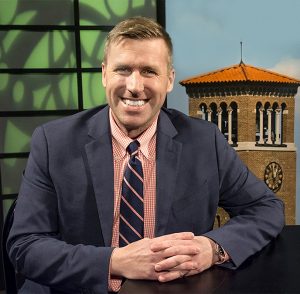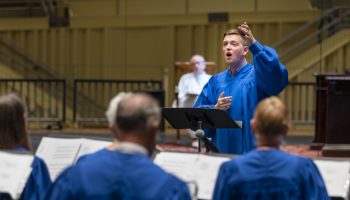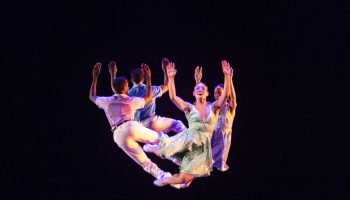Welcome to Week Nine of our 145th Assembly. I cannot believe that we’ve reached the end of our summer season so soon! And while we are always sad when our time together comes to a close, we are going to go out with a bang.
 Week Nine looks at “Documentary Film as Facilitator: Storytelling, Influence and Civil Discourse.” For more than six months, I have been having conversations with acclaimed storyteller and filmmaker Ken Burns. One of the incredible joys of this job is getting to spend time with some of the nation’s brightest minds, and it will surprise no one that Ken is always on that list. For the first two days of our closing week, Ken (on Monday) and his collaborators Dayton Duncan and Geoffrey Ward will be in a dynamic conversation on how film frames our history and gives us clues about our future. These three men are responsible for some of the most gripping documentaries today, and I’m so excited to share a dialogue with them this week. I’m equally excited that we close the week — and our season — with three remarkable women: film critic Ann Hornaday and filmmakers Rebecca Cammisa and Grace Lee, all of whom are doing some of the most thought-provoking work in their respective fields. It’s going to be an incredible week.
Week Nine looks at “Documentary Film as Facilitator: Storytelling, Influence and Civil Discourse.” For more than six months, I have been having conversations with acclaimed storyteller and filmmaker Ken Burns. One of the incredible joys of this job is getting to spend time with some of the nation’s brightest minds, and it will surprise no one that Ken is always on that list. For the first two days of our closing week, Ken (on Monday) and his collaborators Dayton Duncan and Geoffrey Ward will be in a dynamic conversation on how film frames our history and gives us clues about our future. These three men are responsible for some of the most gripping documentaries today, and I’m so excited to share a dialogue with them this week. I’m equally excited that we close the week — and our season — with three remarkable women: film critic Ann Hornaday and filmmakers Rebecca Cammisa and Grace Lee, all of whom are doing some of the most thought-provoking work in their respective fields. It’s going to be an incredible week.
But why film as a closing theme? Is it because we simply want to be entertained after eight weeks of tough topics and in-depth inquiry? Hardly. With crowdsourcing, social media campaigns and new distribution channels, films aimed at affecting social and cultural change have found audiences unlike any time in the history of the art form. As always, our weeks raise questions. How do we measure the impact of such films — from changing minds to changing policy? We will address these and many other questions as filmmakers and film lovers gather for a weeklong festival featuring screenings and conversations in venues throughout the grounds, all alongside the Institution’s renowned lecture and arts programs. We’ll consider the filmmaker’s role and intentions as artist, storyteller, journalist, advocate and activist; the business decisions that influence the distribution and marketing campaigns behind such films; and the effectiveness of films to create empathy — and prompt action — in audiences.
In our companion Interfaith Lecture Series, we look at how religious values continue to be a potent influence in the minds of young, contemporary filmmakers in modern America. How have these filmmakers navigated the difficult and sensitive waters of religion and translated them to the screen? What effects are these films having? In this week, we will witness the power of the visual narrative to change hearts and minds.
And all of this is accompanied by our second annual Chautauqua Food Festival. Bestor Plaza will again come alive with a daily roster of food- and drink-themed events, from cooking demonstrations and competitions to interactive experiences and tastings prepared by the best regional restaurants, farms, wineries and breweries. The best item on the menu, however, is that Bestor Plaza will be alive with crowds who are not only enjoying food but also one another. It’s truly a wonderful symbol of community and a fitting celebration to close our assembly.
Throughout the summer, we have been holding strategic planning listening sessions. I am so grateful to the scores of Chautauquans who have shared their views on our upcoming strategic planning process. We have one more at 3:30 p.m. this Thursday, Aug. 23, in the Hall of Christ. I hope you’ll join me, board of trustees chair Jim Pardo and Strategic Planning Working Group chair Laura Currie to share your final thoughts on the season.
You may have noticed in recent news reports that Chautauqua Institution has filed a petition in Erie County Supreme Court concerning the conservation of Chautauqua Lake. Our petition is not a vote for or against herbicides as a tool to control weeds in the lake. What we seek is a defensible Supplemental Environmental Impact Statement (SEIS). The SEIS documents critical scientific data and findings that serve as the basis on which the New York State Department of Environmental Conservation makes decisions on applications for the use of herbicides in Chautauqua Lake.
As part of the SEIS development process, we filed questions and concerns that were not adequately addressed before the SEIS was finalized. We are asking for our scientifically supported concerns to be addressed before that SEIS is used in the consideration of any future applications for herbicide permits. We look forward to working with all partners around the lake and in the state to create a sound, science-driven, healthy response to ensure the long-term viability of our lake, and we appreciate the broad support we’ve received from you.
In closing, I know we’ve had a lot of conversations this summer about balance on our lecture platform. As we begin to program 2019, I want to thank a group of Chautauquans who met with me and Chief of Staff Matt Ewalt this past week for their thoughtful suggestions about speakers who might provide robust balance to our lecture platform next year. It’s easy to be critical of things one doesn’t like, but far harder to heed the call for solutions-based conversations. I was so pleased that the latter is the kind of meeting we had last week, and I thank that quartet of Chautauquans.
I have one farewell column left later in the week, so I won’t yet tell you how sad it is to see another season come to an end, because this is the beginning of Week Nine, and we have a lot of great conversations, art and wonderful food to consume. May this week’s menu fill you with all the goodness that Chautauqua can provide.




